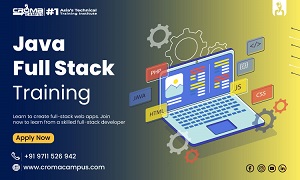A key component in modern software engineering, full-stack development has emerged in today’s fast-paced digital environment. For any Java developer hoping to succeed in the field, learning full-stack development is not only helpful but also necessary.
Java provides developers with a robust toolkit to build dynamic and feature-rich web applications, from the client-side interface to the server-side logic and data management, thanks to its vast ecosystem of frameworks, libraries, and tools. Let’s discuss a few details about Full Stack Java Developer Training and how it can help you achieve your career goals.
What Does It Consist of?
The choice of the Java Full Stack Developer training is given by many, but so the question is this. Here’s what you can expect from a typical Full Stack Java Developer training course:
1. Front End Development
-
HTML: Discover the fundamentals of HTML, which is the basis of any web page, as well as the way to display text content within elements and tags.
-
CSS: Familiarize yourself with CSS, the language used to style HTML elements, and get a grasp on adding interactive, and beautiful layouts and designs.
-
JavaScript: Study Javascript, the most common programming language in the web, and realize that is the perfect tool to create websites more attractive, dynamic and interactive.
2. Back End Development
-
Java: The Java programming language is one of the most widely used ones among web developers.
-
Spring Framework: Talk about one of the most widespread Java frameworks, Spring Framework, which is perfect for enterprise applications.
3. Database Management
-
MySQL: Through this process gain practical experience of working with MySQL, which is among the most popular systems for relationship database management.
-
Hibernate: Hibernate is one of the most famous tools for creating an Object-Relational Mapping Framework for Java.
4. Version Control
-
Git: Be knowledgeable with Git, a distributed version control system, that could enable you to perform other activities including manipulation of project code and collaboration with other developers.
5. Project-Based Learning
-
Hands-on Projects: Participate in professional projects and execute assignments as a real-world experience to reinforce your knowledge on a practical level and create a portfolio.
-
Capstone Project: Complete the final assignment to display knowledge of the Java Full Stack Developer tools and show competence.
Benefits of Learning
Here are a few key Benefits of Learning Java, mentioned below:
1. Comprehensive Skill Set:
The study of Java Full Stack Development gives you a complete stack of technology consisting of both web and applications technologies.
2. End-to-End Application Development:
Be able to understand how an application is created, from designing user interfaces and employing business logic to linking to databases.
3. Industry-Relevant Technologies:
Obtain information on commonly used industry software and technologies including Spring, Hibernate, Angular, or React among others.
4. Scalable and Robust Solutions:
Learn to develop Java-based web applications and services which are; scalable, robust and high-performing.
5. Career Advancement Opportunities:
Java Full Stack expertise offers a bunch of career advancement paths in software development, taking on technical leadership.
Conclusion
Java Full Stack Developer training courses provide a comprehensive and structured pathway to mastering the skills needed to succeed in the fast-paced world of web development.
So, why wait? Enrol in a Java Full Stack Developer training course today and embark on a rewarding and fulfilling career journey!

